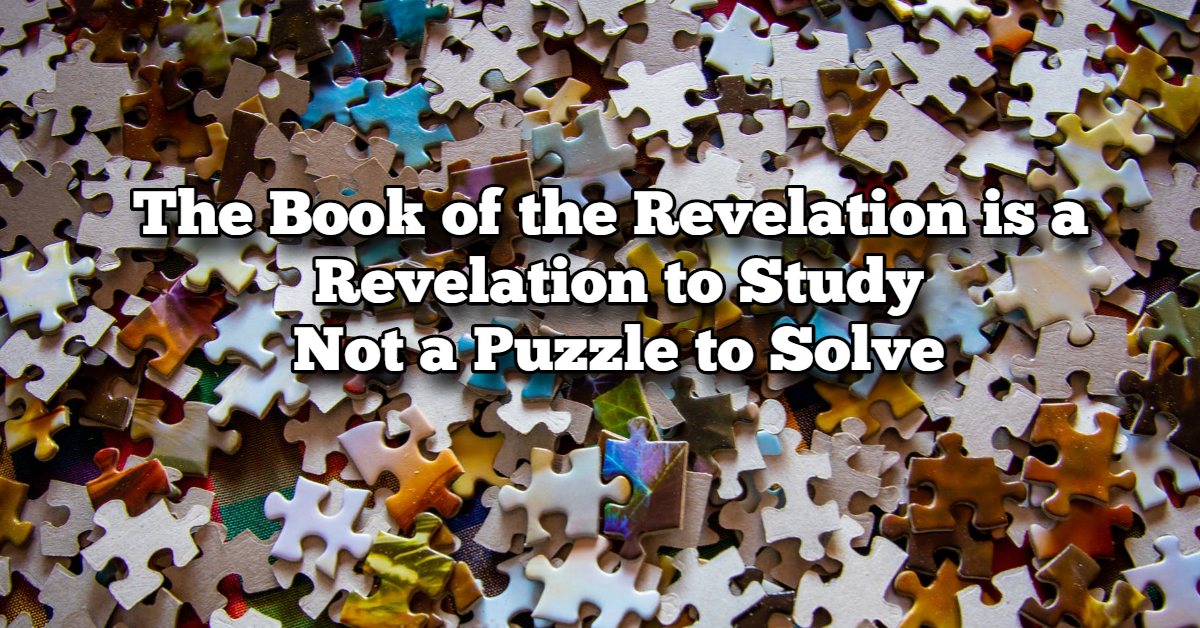It is with much fear and trepidation I take on the study of The Revelation of Jesus Christ. This is because I come from a background that has abused the book. So, I fear I will get it wrong.
If I did not comment about the book, I would stand in a line of notable theologieans. Others have avoided it. For example, Calvin’s commentary covers every book in the Bible except Revelation.
In recent weeks it appears God has put before me several good resources on this book. So it is with much fear, trembling, much humility I attempt this series.
This will not be an attempt to understand the hidden things of God. They belong to God. They are not for us. Rather it is an attempt to understand what God has revealed. After all, this is the Revelation of Jesus Christ, not the book of the hidden mysteries of Jesus Christ.
Dating of the book.
Uncertainty about when John wrote the book is one reason for the confusion over interpretation. You cannot comment on the book without making an assumption about when John wrote it. It is clear John wrote during a time of persecution. That would give us two possible time frames. The first is near the end of the reign of Nero (54-68 a.d.). Second is during the reign of Domitian (81-96 a.d.) Most scholars favor a later date. This is because if a comment from Irenaeus in Against Heresies. In it, Irenaeus states John’s vision was near the end of the reign of Domitian.
But there is a large minority of scholars who place the date before 70 a.d. That is during the reign of Nero. They base this dating on internal evidence in the book. They claim the book itself points to a time before 70 a.d. Several times John makes the comment that the prophecy will be fulfilled very soon. You have a hard time claiming 2000 years is very soon.
Literary Style
The literary style of the book is apocalyptic. That means it is very imaginative. It makes strong use of symbols and images. Revelation uses strong images for promises and warnings. It recalls a lot of Old Testament prophecies and promises.
Many have abused the use of symbols in the text. Even those who claim to take the book literally must recognize the use of symbols. Here is an example of silliness. In chapter 9, the claim the giant locusts are Apache helicopters. Wait a minute. If you take it literally they have to be locusts. They cannot be helicopters. Everyone understands these are symbols. They are a representation even to those who claim they take it literally.
The main part of the book is made up of seven cycles of Judgment. (4:1-8:1; 8:2-11: 19;12:1-14:20; 16:1-16:21; 17:1-19:10; 19:11-21; 20:1-15)
Scholars debate how we are to understand these cycles. Some argue they are parallel. That is, they look at the same events from different viewpoints. Others understand the cycles as sequential. Some believe they are a partial recapitulation. And these people say there are overlays between the cycles. Some see the cycles as telescoping. (The seventh sea; contains all the trumpet judgments. The seventh trumpet contains all the bowl judgments.)
The structure of the book is arranged as a chiasm. A chiasm is a literary feature. It derives its name from the Greek letter chi. Chi looks like an X. It involves sequences of parallel elements that bookend a central concept. Another way of describing this literary device is as a thematic pyramid. It goes up one side to a central point. Then it goes down in a similar way on the other side.
There are various outlines of the book. Here are two. Both show the chiastic structure of the book.
Outeline1
A Church Suffering and enduing 1:4-3:22
B Righteous Suffering 4:1 – 8:1
C Wicked Suffering in history 8:2-11:19
D Christ is victorious
C’ Wicked Judged At the end of history 14:6-20
B’ Righteous delivered from suffering 15:1-16:21
A’ Church Vindicated 17:1-22:5
Outline 2
A The People of God
B The Dragon
C The Beast and the False Prophet
D The Bride
E Babylon the Harlot
E’ Babylon Destroyed
D’ The Bride Blessed
C’ The Beast and False Prophet Destroyed
B’ The Dragon Destroyed
A’ The People of God
Primary Theme
The book shows God is sovereign. He reigns over history. God will bring a triumphant climactic end with Christ. God is judge and ruler. He displays His majesty, authority, and righteousness over all the universe.
A second theme of the book is Christ is King. The book shows Christ as the majestic king and judge.
There is an already but not yet aspect of the book. Christ has defeated Satan. But Satan’s is angry and wars against the church. Satan never wars against God. That would be futile. He wars against the church.
Satan tries to counterfeit God. There is a counterfeit nature to his forces. Satan continues to counterfeit God in hopes of deceiving men.
There is a continuing fulfillment of the Old Testament prophecy. And we see the willingness to suffer for Christ is the path to victory.
Approaches to The Revelation
There are four major approaches to the book. Within each approach, there are many variations. But there are four basic approaches. The first approach is Preterism. Preterism holds to an early dating of the book. (Note: You do not need to be a preterist to hold to an early dating) They hold an early dating because they believe much of the prophecy was fulfilled in 70 a.d. The destruction of Jerusalem and the temple fulfilled much of the prophecy. Radical preterist holds all the prophecies were fulfilled in 70 a.d. This includes the return of Christ. Partial preterism holds the return of Christ and the final judgment are yet to come. They make much of the fact John says many of the judgments were coming soon.
Another approach is Futurism. Futurism holds that chapters 6-18 will occur in a final crisis right before the return of Christ. Chapters 19-22 foretell of the second coming, resurrection and judgment. The best know form of futurism today is dispensationalism. But even among dispensationalists, there are some significant differences.
A third approach is Historicism. Historicism claims Chapters 6-18 offers a history of the church. They ask the question what chapter are we in? During the Reformation, almost all protestants were historical interpreters. But today Historicism has almost disappeared.
The final approach is Idealism. Idealism says The Revelation represents trends and spiritual forces. So they are invisible. The visions are not special events. But they are ongoing principles and patterns of spiritual warfare.
While these approaches are often in conflict they are not contradictory. So the truth is most likely a combination of the four.
Special Issues
Often the debate about The Revelation centers around some specific concerns. These are Premillennialism, Postmillennialism, and Amillennialism. And within those, when is the rapture? Does it occur, pre-tribulation, mid-tribulation, or post-tribulation?
Growing up I remember your salvation was questioned if you held the “wrong” view. That is silly. Our salvation is not based on our view of the rapture, the tribulation, or the millennial reign of Christ. Our salvation comes from the blood of Jesus.
Approach to Interpretation
Well, you may wonder where I stand on these positions. Please note my answers change almost daily. Right now I hold to partial preterism, idealism, amillennial, view. We will see if it holds up by the end of the study. But the important part is I believe in the bodily resurrection. And Christ will come again in judgment for the living and the dead.
I am open to letting the text teach and correct me. So the approach in this study is to exam the text. What does it say? To whom was it written? How would they have understood it?
John (or rather Christ) addressed Revelation to 7 churches. We must bear that in mind in interpreting the book. These churches were real churches. They were in what is now western Turkey. Christ rebuked and encouraged each church.
Rev 1:1 “This is the revelation of Jesus Christ…” This is not the “Mysteries of Jesus Christ.” It is this is a revelation. It reveals not conceals. We ought to be able to understand it. But so much of the time, men have wrapped it in weird silliness. They have made it a waxed nose to mean that they want if to mean.
To understand The Revelation we need to use sound hermeneutics. Hermeneutics is the science of interpretation. We need to understand the type of literature. Where has the bible used similar symbolism? How did the original audience understand it? This is how we understand the rest of the bible. We should use it to understand The Revelation of Jesus Christ.
So let us approach it as if it were understandable. Let’s not approach it as if it were a hidden puzzle to solve.


Leave a Reply